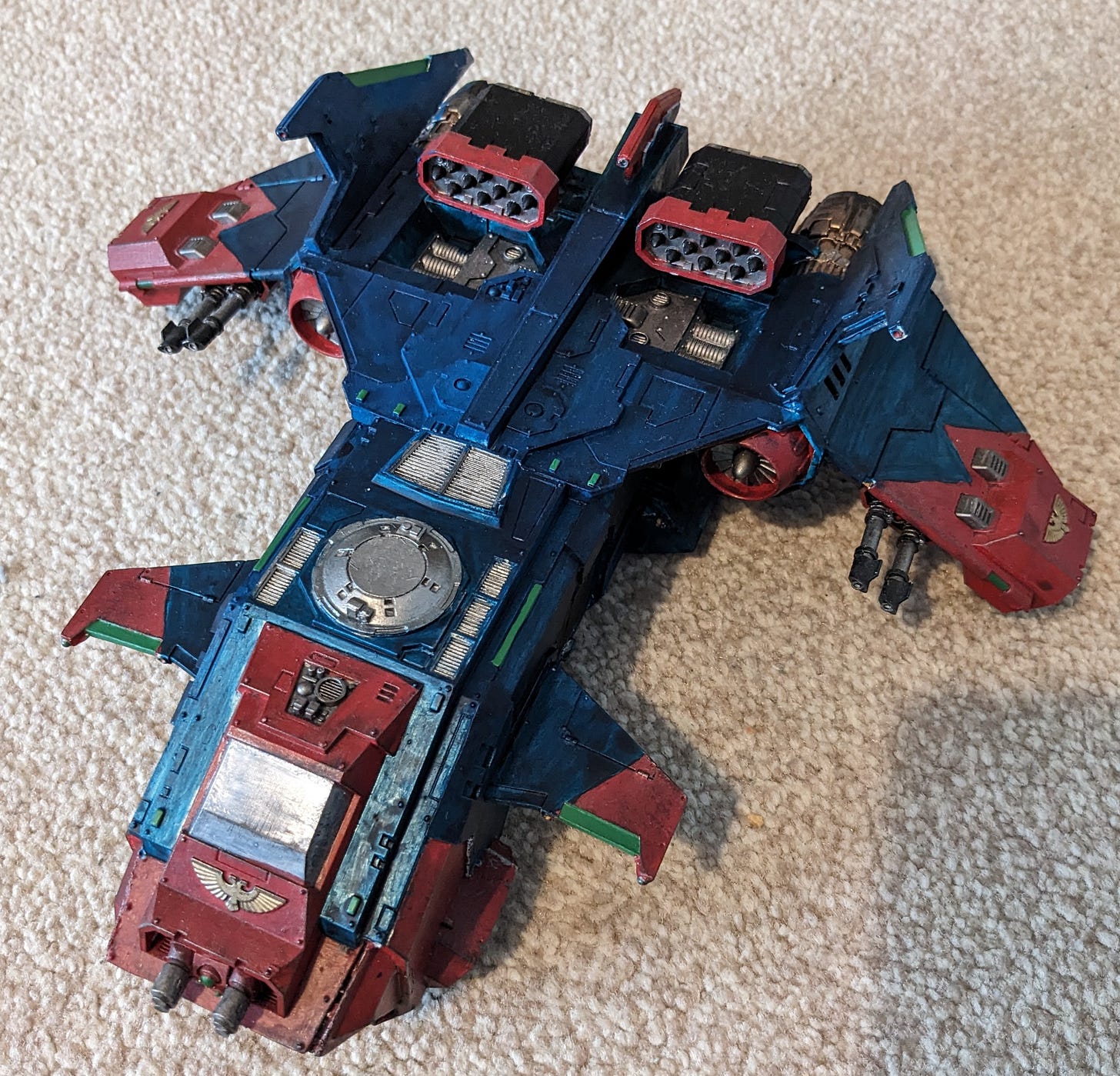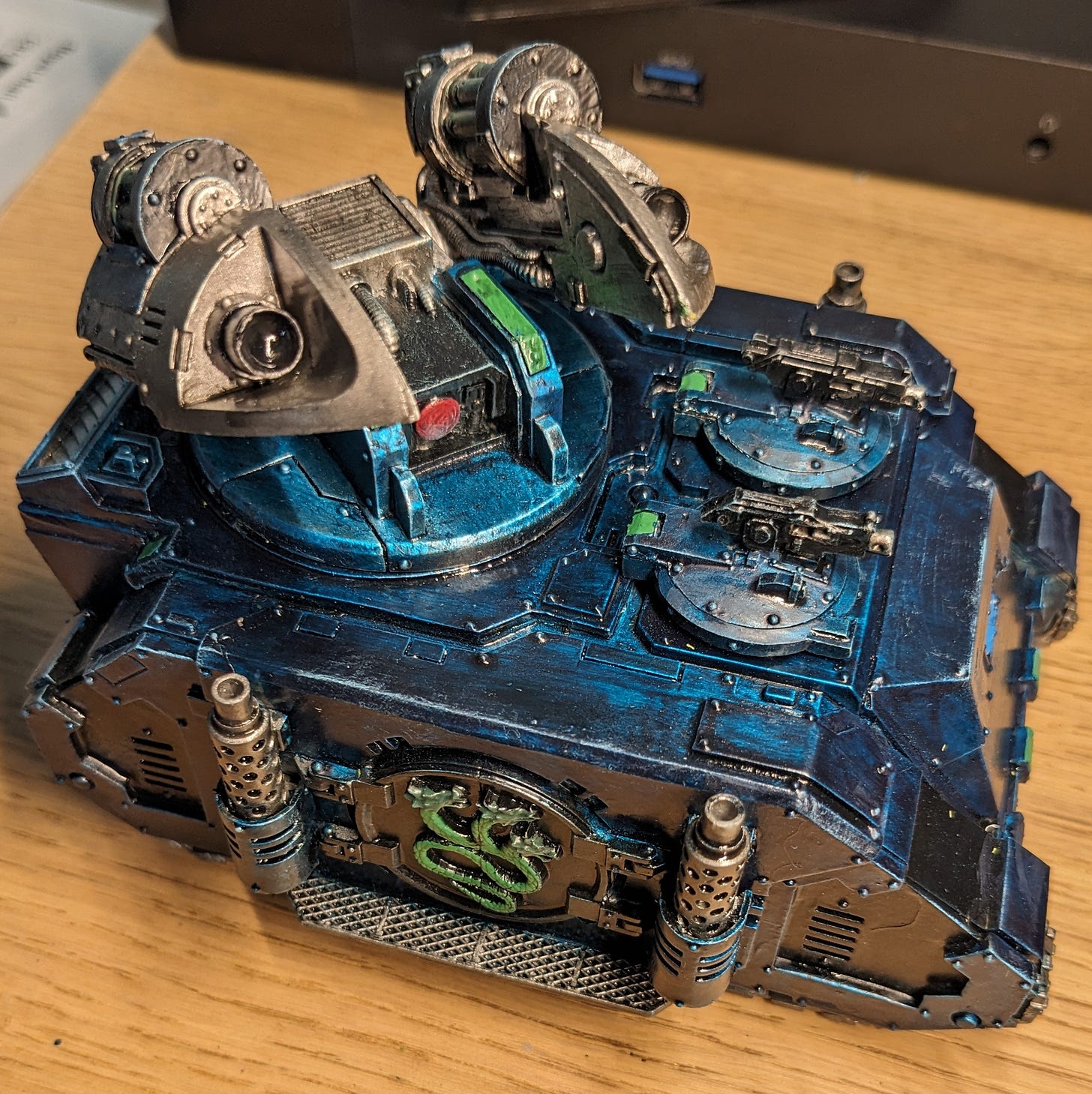Modern era wargaming lessons from a Horus Heresy game
Trying to apply Combined Arms theory in a science fiction setting, because why not?
I originally posted this article on my other Substack on the 6th January 2025.
I wrote this post maybe about a year ago, and then did some updating recently.
It’s not my best work I’ll admit that now. The explanations are too simplistic and the introduction too long. I’m not sure its detailed enough for wider interest and my conclusions are too brief.
However, I’m posting it up anyway for the purposes of critique and comment. I can do better, and I hope to have the time to do so in 2025. Let’s see.
On with the Substack, please comment and let me know how I can do better.
I lost multiple units, failed to destroy even one of my opponent’s units, failed to concentrate my firepower or manoeuvre properly, rolled terribly (dice I mean) and was terribly distracted and sleep deprived (my youngest son was sick).
I lost the game.
Yet I immensely enjoyed it and learnt a considerable amount, particularly around applying modern combined arms tactics.
‘But in a sci-fi game?’ I hear you ask.
Yes. Let me explain.
What is ‘The Horus Heresy’?
The ‘Warhammer: Age of Darkness.’ or simply ‘The Horus Heresy’ is a science fiction rules set and fictional setting, from the larger ‘Warhammer 40,000’ fictional universe.
The wargame uses a heavily modified version of Warhammer 40k 7th edition wargames rules as it’s base, a rule set that has a wonderful amount of detail without being too heavily laden. It is this detail that makes it not only a good system, but also detailed enough to apply some modern tactics and strategies to it.
Tanks, artillery, infantry fighting vehicles, air power, airborne assaults, urban combat, all these aspects and more can be properly played out using this system. Science fiction the setting might be, but modern battle tactics can certainly work here.
‘Didn’t you just say you lost the game?’
Yes, I did, and so here documented for your interest is what I learnt from that loss.
Airpower: a practical and psychological weapon
My opponent hadn’t seen it coming. In turn 2 I placed on the gaming board what I thought would be a weapon to turn the tide. A Storm Eagle gunship.

It’s something a-kin to a helicopter gunship, such as an MI-24 Hind. Built as a flying tank it has armour and is festooned with weaponry, particularly the configuration I deployed, of the anti-tank variety. It’s also a big model, intimidating in its size and rarely seen on the tabletop.
In the end, it was not to swing the battle in my favour.
Despite its formidable arsenal my appalling dice rolling (8 x rolls of a 1 on Six-sided dice, all rolled at the same time) meant all its attacks failed. Whilst it survived the game, it did so mainly to remind me it hadn’t done what was expected of it.
But I did show two aspects of air power.
One is practical. It was a very powerful weapon, configured for anti-tank duty. It could specifically target anything on the gaming board and with my opponent’s army setup, he had very little that could fire back with much accuracy or damage. It could swoop in on anyone or anything and smash them...if you rolled your dice well enough.
Exactly as air power should do on a modern battlefield. Unless you have sufficient and capable anti-aircraft defences, the likes of a fast jet or attack helicopter can bring a lot of firepower to bear, accurately and continuously. Look to coalition air power during the wars in Iraq and Afghanistan.
Look also more recently at Russian air attacks on certain parts of the Ukraine front in April and March of 2024; where due to a shortage of anti-aircraft missiles, Russian Air force SU-25 ground attack aircraft were able to help Russian infantry directly for the first time in months.
But during the game I was playing I also noticed a perhaps overlooked aspect of air power, both in reality and on the wargaming table.
The psychological effect.
My opponent was not expecting me to bring air power. He certainly wasn’t expecting a gunship. The sudden realization that he had nothing that could take down this aircraft had the potential to really throw off his game plan.
In the end, he didn’t need to worry. He had already inflicted a lot of damage on my army and my aircraft turned out to be nowhere near as effective as both he and I expected.
But still, it was an affect I noted. It was a combination of an unexpected weapon system, and the realization of not having anything ready to combat it. This could have turned the game for me and had nothing to do with the units capabilities.
It was just that it was unexpected, big, had lots of guns and could fly.
Accurate Artillery: The God of War
I brought 2 pieces of rocket artillery to the game. The ‘Whirlwind’ and ‘Scorpius’, two very similar rocket artillery systems. The Whirlwind was my ‘Swiss army knife’ able to fire out Anti-tank. Anti-infantry and Anti-aircraft missiles, whilst the Scorpius was more of a powerful saturation weapon designed to cause damage to anything up to a light vehicle. They were, to my mind, a good choice.
Especially given that my enemy was deploying a primarily infantry-based army. I could theoretically rain great destruction down upon him from long range.
I could also do so accurately. Several of my forward deployed units were equipped with a device known in the game as a ‘Nuncio-Vox’. This is effectively a laser range finder and helps with accuracy of barrages.
Again, it was good in theory. Unfortunately a number of factors resulted in this not quite going to plan.
First, I forward deployed a large sniper team, equipped with a Nuncio-Vox, too far forward. They were attacked almost immediately so their advantage was gone. No accurate artillery could be placed with their help.
Second, I split my fire. Instead of concentrating on just one target I tried to hit two different squads.
Third, the rocket artillery vehicles themselves were deployed too far forward so in quick order my opponent’s vanguard units actually managed to threaten them and by the end of the game had destroyed one of the units.
Despite these setbacks, the theory is sound. Even my opponent pointed that out. If the sniper team has been deployed further back, and the barrages coordinated on just one target, an entire unit could have been wiped out per turn easily.
My lesson was learnt. Keep the long-range units further back. Let the enemy come to you and let him pay in blood for every move.
Infantry swarm: Attrition in depth
Now for a lesson I learnt from my opponent.
He used a primary infantry-based army. The individual infantry squads were fast, large, well armoured, inter-supporting and configured for specific tasks.
This army had many advantages.
The large squads were easy to manage. Each excelled at their individual task such as supporting fire or infantry assault.
Their armour allowed them to weather return fire and the simple number of bodies meant a lot of firepower was required to render them ineffective.
But the army came with many disadvantages as well.
The army was highly suspectable to area-effect anti-infantry weapons. Even if these weapons missed, they still had a good chance of hitting something amongst the mass of troops.
Additionally, when the individual squads encountered a threat, they were not configured to fight e.g. assault squad against a tank, their effectiveness was depleted. They either got stuck engaging a hard to destroy target or had to wait for support.
They were likewise slower than vehicle born infantry.
Finally, when certain elements were eliminated from individual squads e.g. medics, the individual squads lost a lot of their effectiveness.
They still won, yes, but the over specialization meant that if certain key factors had been different, for example my own army configuration or the mission being played, the army would not have worked.
Conclusions: Lessons Learnt
This game took place at the start of 2024, and I would have loved to have organised a re-match with my many lessons learnt. But for now, in a nutshell I learnt:
· When employed correctly, air power is a powerful practical and psychological weapon. It needs careful consideration though and backup (two aircraft would have been better)
· Artillery works but needs correct placement and target selection.
· Over specialization doesn’t work. Some adaptability is needed.
Thanks for reading all. Critique and comments welcome. Have a nice day.
Thanks for reading Modern Warfare and Wargaming! Subscribe for free to receive new posts and support my work.





It also helps to go in with at least some thoughts about what to do when your first two plans fail.